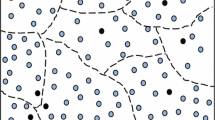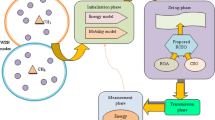Abstract
Due to the battery limitations, energy-efficient routing is one of the most important issues in WSNs. In this paper, a novel distributed clustering routing protocol (NODIC) is proposed. The algorithm makes three main contributions to literature. Firstly, a time-sharing approach for CH election is suggested differently from the studies in literature. The most effective parameters are combined in a time-sharing approach on the purpose of gaining the highest performance. Secondly, easy implementation and self-reliant decision of probabilistic schemes and the guarantee that iterative schemes issue about selecting the desired CHs are pieced together without using any of them. Finally, since CH decision is performed locally and dynamically, the clusters can make their decisions independently from the others. NODIC is compared with three common corresponding approaches in literature for various values of the number of nodes and under different traffic distributions. The algorithms are evaluated by using the number of living nodes and total energy consumptions per round. The results show that NODIC performs considerably better than the other approaches for all number of nodes and under all distributions up to 79 %.














Similar content being viewed by others
References
Singh, S. K., Singh, M. P., & Singh, D. K. (2010). Routing protocols in wireless sensor networks—A survey. International Journal of Computer Science & Engineering Survey (IJCSES), 1, 63–83.
Li, M., Li, Z., & Vasilakos, A. V. (2013). A survey on topology control in wireless sensor networks: Taxonomy, comparative study, and open issues. Proceedings of the IEEE, 101(12), 2538–2557.
Naeimi, S., Ghafghazi, H., Chow, C. O., & Ishii, H. (2012). A survey on the taxonomy of cluster-based routing protocols for homogeneous wireless sensor networks. Sensors, 12(6), 7350–7409.
Wei, G., Ling, Y., Guo, B., Xiao, B., & Vasilakos, A. V. (2011). Prediction-based data aggregation in wireless sensor networks: Combining grey model and Kalman filter. Computer Communications, 34(6), 793–802.
Yao, Y., Cao, Q., & Vasilakos, A. V. (2013). EDAL: An energy-efficient, delay-aware, and lifetime-balancing data collection protocol for wireless sensor networks. In 2013 IEEE 10th international conference on mobile ad-hoc and sensor systems (MASS) (pp. 292–190), IEEE.
Yao, Y., Cao, Q., & Vasilakos, A. V. (2015). EDAL: An energy-efficient, delay-aware, and lifetime-balancing data collection protocol for heterogeneous wireless sensor networks. IEEE/ACM Transactions on Networking, 23(3), 810–823.
Zeng, Y., Li, D., & Vasilakos, A. V. (2013). Real-time data report and task execution in wireless sensor and actuator networks using self-aware mobile actuators. Computer Communications, 36(9), 988–997.
Xiao, Y., Peng, M., Gibson, J., Xie, G. G., Du, D. Z., & Vasilakos, A. V. (2012). Tight performance bounds of multihop fair access for MAC protocols in wireless sensor networks and underwater sensor networks. Mobile Computing, IEEE Transactions on, 11(10), 1538–1554.
Xiang, L., Luo, J., & Vasilakos, A. (2011). Compressed data aggregation for energy efficient wireless sensor networks. In 2011 8th annual IEEE communications society conference on sensor, mesh and ad hoc communications and networks (SECON) (pp. 46–54), IEEE.
Chilamkurti, N., Zeadally, S., Vasilakos, A., & Sharma, V. (2009). Cross-layer support for energy efficient routing in wireless sensor networks. Journal of Sensors, 2009, 1–9.
Liu, Y., Xiong, N., Zhao, Y., Vasilakos, A. V., Gao, J., & Jia, Y. (2010). Multi-layer clustering routing algorithm for wireless vehicular sensor networks. IET Communications, 4(7), 810–816.
Meng, T., Wu, F., Yang, Z., Chen, G., & Vasilakos, A. (2015). Spatial reusability-aware routing in multi-hop wireless networks. IEEE Transactions on Computers, PP(99). doi:10.1109/TC.2015.2417543.
Marwaha, S., Srinivasan, D., Tham, C. K., & Vasilakos, A. (2004). Evolutionary fuzzy multi-objective routing for wireless mobile ad hoc networks. In Congress on evolutionary computation, 2004 (CEC2004) (vol. 2, pp. 1964–1971), IEEE.
Liu, X. Y., Zhu, Y., Kong, L., Liu, C., Gu, Y., Vasilakos, A. V., & Wu, M. Y. (2015). CDC: Compressive data collection for wireless sensor networks. IEEE Transactions on Parallel and Distributed Systems, 26(8), 2188–2197.
Youssef, M., Ibrahim, M., Abdelatif, M., Chen, L., & Vasilakos, A. V. (2014). Routing metrics of cognitive radio networks: A survey. Communications Surveys & Tutorials, IEEE, 16(1), 92–109.
Li, P., Guo, S., Yu, S., & Vasilakos, A. V. (2012). CodePipe: An opportunistic feeding and routing protocol for reliable multicast with pipelined network coding. In INFOCOM, 2012 Proceedings of the IEEE (pp. 100–108), IEEE.
Song, Y., Liu, L., Ma, H., & Vasilakos, A. V. (2014). A biology-based algorithm to minimal exposure problem of wireless sensor networks. IEEE Transactions on Network and Service Management, 11(3), 417–430.
Liu, L., Song, Y., Zhang, H., Ma, H., & Vasilakos, A. V. (2015). Physarum optimization: A biology-inspired algorithm for the steiner tree problem in networks. IEEE Transactions on Computers, 64(3), 819–832.
Busch, C., Kannan, R., & Vasilakos, A. V. (2012). Approximating congestion + dilation in networks via quality of routing&# x201D; games. IEEE Transactions on Computers, 61(9), 1270–1283.
Xu, X., Ansari, R., Khokhar, A., & Vasilakos, A. V. (2015). Hierarchical data aggregation using compressive sensing (HDACS) in WSNs. ACM Transactions on Sensor Networks (TOSN), 11(3), 45.
Li, P., Guo, S., Yu, S., & Vasilakos, A. V. (2014). Reliable multicast with pipelined network coding using opportunistic feeding and routing. Parallel and Distributed Systems, IEEE Transactions on, 25(12), 3264–3273.
Meng, T., Wu, F., Yang, Z., Chen, G., & Vasilakos, A. (2015). Spatial reusability-aware routing in multi-hop wireless networks. IEEE TMC,. doi:10.1109/TC.2015.2417543.
Liu, X. (2012). A survey on clustering routing protocols in wireless sensor networks. Sensors, 12(8), 11113–11153.
Sikander, G., Zafar, M. H., Raza, A., Babar, M. I., Mahmud, S. A., & Khan, G. M. (2013). A survey of cluster-based routing schemes for wireless sensor networks. SmartCR, 3(4), 261–275.
Hussain, K., Abdullah, A. H., Awan, K. M., Ahsan, F., & Hussain, A. (2013). Cluster head election schemes for WSN and MANET: A survey. World Applied Sciences Journal, 23(5), 611–620.
Heinzelman, W. R., Chandrakasan, A., & Balakrishnan, H. (2000). Energy-efficient communication protocol for wireless microsensor networks. In Proceedings of the 33rd annual Hawaii international conference (p. 10), Maui, HI, USA.
Heinzelman, W. B., Chandrakasan, A. P., & Balakrishnan, H. (2002). An application-specific protocol architecture for wireless microsensor networks. IEEE Transactions Wireless Communications, 1, 660–670.
Peng. D., & Zhang, Q. (2010). An energy efficient cluster-routing protocol for wireless sensor networks. In Proceedings of the international conference on computer design and applications (ICCDA2010) (pp. V2-530–V532-533), Qinhuangdao, China.
Jing, C., & Hong, S. (2008). Meleach-l: More energy-efficient leach for large-scale Wsns, WIRELESS COMMUNICATIONS. In Proceedings of the 4th international conference on networking and mobile computing (WiCOM 2008) (pp. 1–4), Dalian, China.
Younis, O., & Fahmy, S. (2004). HEED: A hybrid, energy-efficient, distributed clustering approach for ad-hoc sensor networks. IEEE Transactions Mobile Computing, 3, 366–379.
Zhang, H. Z., Chen, P. P., & Gong, S. L. (2010). Weighted spanning tree clustering routing algorithm based on leach. In Proceedings of the 2nd international conference on future computer and communication (ICFCC 2010) (pp. V2-223–V222-227), Wuhan, China.
Bian, X. X., Liu, X. C., & Cho, H. (2008). Study on a cluster-chain routing protocol in wireless sensor networks. In Proceedings of the 3rd international conference on communications and networking (ChinaCom 2008) (pp. 964–968), Hangzhou, China.
Ding, P., Holliday, J., & Celik, A. (2005). Distributed energy efficient hierarchical clustering for wireless sensor networks. In Proceedings of the 8th IEEE international conference on distributed computing in sensor systems (DCOSS) (pp. 322–339), Marina Del Rey, CA, USA.
Prabhu, S. B., Mahalakshmi, R., Nithya, S., & Sophia, S. (2013). A review of energy efficient clustering algorithm for connecting wireless sensor network fields. International Journal of Engineering Research and Technology, 2(4), 477–481.
Rashed, M., Kabir, M. H., Rahim, M. S., & Ullah, S. E. (2012). Cluster based hierarchical routing protocol for wireless sensor network. arXiv preprint arXiv:1207.3876.
Zhu, X., Shen, L., & Yum, T. S. P. (2009). Hausdorff clustering and minimum energy routing for wireless sensor networks. IEEE Transactions on Vehicular Technology, 58(2), 990–997.
Kandris, D., Tsioumas, P., Tzes, A., Nikolakopoulos, G., & Vergados, D. D. (2009). Power conservation through energy efficient routing in wireless sensor networks. Sensors, 9(9), 7320–7342.
Varga, A. (2001). The OMNeT++ discrete event simulation system. In Proceedings of the European simulation multiconference (ESM’2001), 9(S 295) (p. 65).
Tohma, K., Aydin, M. N., & Abasikeles-Turgut, I. (2015). Improving the LEACH protocol on wireless sensor network. In 23th Signal processing and communications applications conference (SIU) (pp. 240–243), IEEE.
Acknowledgments
We would like to thank the Scientific and Technological Research Council of Turkey (TÜBİTAK-EEEAG—115E211) for supporting this work.
Author information
Authors and Affiliations
Corresponding author
Rights and permissions
About this article
Cite this article
Abasıkeleş-Turgut, İ., Hafif, O.G. NODIC: a novel distributed clustering routing protocol in WSNs by using a time-sharing approach for CH election. Wireless Netw 22, 1023–1034 (2016). https://doi.org/10.1007/s11276-015-1045-6
Published:
Issue Date:
DOI: https://doi.org/10.1007/s11276-015-1045-6




